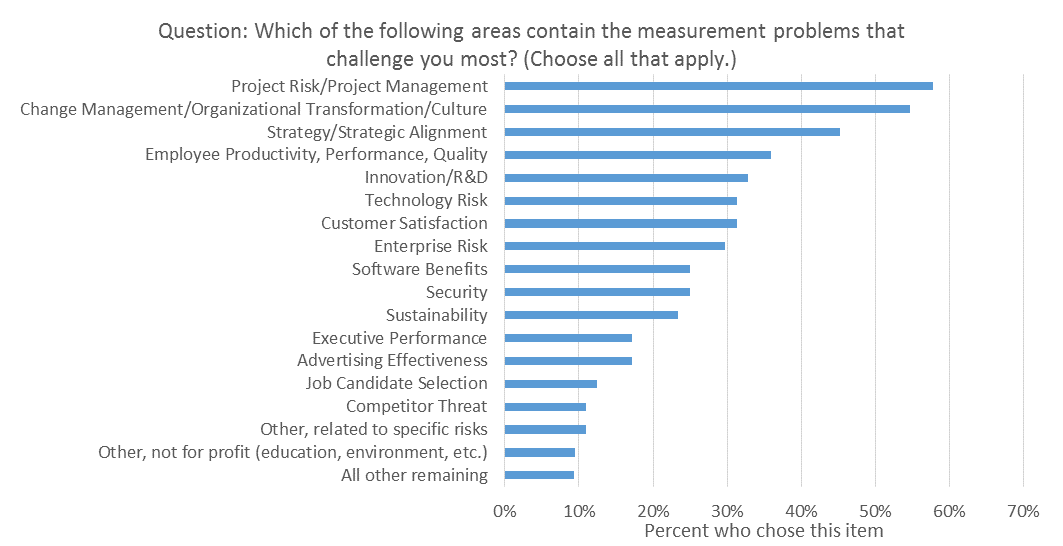According to our recently completed “Measurement Challenges” survey, project risk and project management-related issues are the #1 most frequently identified measurement challenges, followed closely by change management and organizational transformation. The survey also showed that while only half have received training to address these problems, the majority feel they need training in statistical methods or even the analytical methods provided in Excel. This is a brief summary of the findings of that survey.
The survey consisted of a total of 20 questions related to what measurement challenges and the attempts to address them. There were 80 respondents who were roughly evenly divided among analysts, middle managers and executives. They were from 34 different types of industries and government organizations, most of which had greater than 100 staff and 16% had over 10,000 staff.
In one question the respondents were asked to identify key measurement challenges in their organization. They were given 15 specific areas to identify and they were allowed to provide open-ended responses for measurement areas not listed. From the open ended responses, three more categories were identified for a total of 18. Respondents could choose more than one category. See the summary in the chart below.

These results were the basis of the Hubbard Decision Research initiative to develop new training to solve measurement challenges specifically in Project Management and Organizational Transformation. There are a few other noteworthy observations summarized below.
- Soft methods are common in difficult measurement problems. 60% said they use soft methods on at least some measurements somewhere in their organization. Regarding items they identified as important measurement challenges specifically, 45% of respondents stated that they rely on “soft” measurements (scores, verbal labels such as “high” or “low”) or nothing at all (intuition alone).
- Methods being used, even statistical methods, are not being measured for validity. 43% say they use some sort of “statistical/analytical” method, but most of those (82%) are unsure of the validity of these methods.
- Training is needed. Although 70% said they lacked the skills required to solve these measurement problems without additional training, only about half (53%) have not previously attended training on their measurement topics of interest.
- Specifically, training with analytical tools is demanded. Of the analytical tools, Excel was the most used (47%) and the most often identified as the tool for which further training is needed (83%). The statistical package R is currently used by the organizations of only 5% of respondents but it may be “up and coming” because one third (33%) felt they needed to be trained in this package.
- Communicating to management is a challenge of its own. 72% said they are unable to communicate quantitative results to upper management.
- Some still believe these things can’t be measured or they lack the data for it. Only 19% believed the measurement challenges they identified were fundamentally immeasurable and 42% believed they simply lacked the data for the measurement.
As readers and students in our courses know, we don’t believe anything is fundamentally immeasurable. We also argue that a perceived lack of data is not as big an obstacle as is often thought because we often have more data than we think (if we are resourceful) and we need less than we think (if we actually do the math). We also know that much of the required training to solve these problems is probably more accessible than many might think. If you are interested in learning more about how to solve the major measurement challenges of your organization, see the training provided by Hubbard Decision Research.
Doug Hubbard

